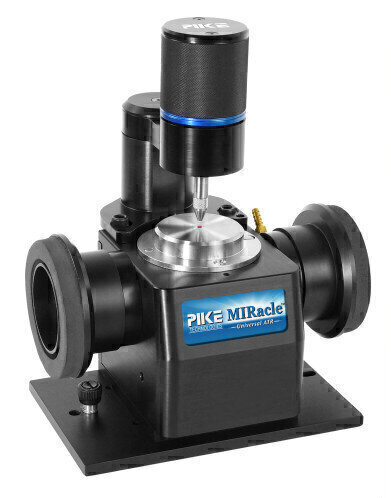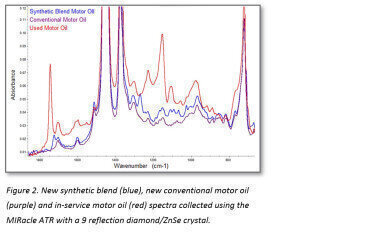-
 Figure 1: PIKE MIRacle ATR accessory
Figure 1: PIKE MIRacle ATR accessory -
 Figure 2
Figure 2
Mass Spectrometry & Spectroscopy
FTIR Monitoring of Lubricating Oils Using a Low Volume, Multiple Reflection ATR
May 01 2019
Introduction
Lubricating oils are often subjected to harsh operating environments, which results in reduced oil performance, depleted additives, and unwanted oxidative byproduct formation. This can lead to excessive wear and catastrophic equipment failure. To screen and monitor lubricating oils, infrared transmission analysis is popular due to its yield of informative data, its simplicity, and its being a relatively low-cost method. Among the parameters IR can evaluate are chemical oxidation, additive depletion, and water and soot contamination. The aim of this application note is to investigate the suitability of a low volume, multiple reflection ATR for the analysis of lubricating oils, and discuss advantages of small volume ATR sampling.
Experimental Conditions
In-service and commercially-available synthetic blend and conventional motor oils were analyzed using the MIRacle ATR accessory (Figure 1) equipped with a 9-reflection diamond/ZnSe crystal plate. 32 scans were co-added for the background and sample spectrum. The FTIR spectrometer was equipped with a DTGS detector.
Results
A multiple reflection ATR accessory offers the advantage of enhanced sensitivity because the magnitude of the absorbance bands are increased relative to a single reflection ATR accessory. This is important when measuring low concentration components such as additives and oxidative chemicals in products such as lubricating oils.
Another advantage of this particular multiple reflection ATR, the MIRacle with a 9-reflection diamond/ZnSe crystal, is its crystal size. The sampling surface diameter is 5 mm. Considering the low depth of penetration of the beam into the sample, less than a few microns, only a small smear of sample across the crystal is sufficient to obtain a quality spectrum. This extremely low sample volume makes this ATR crystal trough plate design ideal for easy cleaning with limited amount of solvents as well as for the analysis of samples where limited mass is available.
The fingerprint region of the FTIR-ATR spectra of motor oil is shown in Figure 2. Comparing spectra from the two new motor oils, absorbance bands difference suggests the additive formulation in each oil is not the same. In the spectrum of the in-service (3,500 miles) oil spectrum, carbonyl oxidation band at 1,750 cm-1 is clearly visible; the magnitude of the absorbance band is nearly 0.08 AU. The band at 1150 cm-1 is associated with sulfate oxidation.1 These spectra support that the MIRacle with a 9-reflection diamond/ZnSe crystal plate has adequate sensitivity to differentiate oil formulations and to gauge oil life. This ATR accessory may find application use in research and development laboratories as well as the field such as oil monitoring programs.
Conclusions
The MIRacle 9-reflection diamond/ZnSe ATR is a useful tool to analyze low concentration components in liquid samples such as motor oil. The small sampling surface area allows for an extremely low sample volume making it ideal for mass-limited samples and also reducing the volume of cleaning solvent required.
For further information please click here.
Reference
1R. Nguele, H.S. Al-Salim, and K Mohannad, Lubricants 2, 206-222 (2014).
Digital Edition
ILM 49.5 July
July 2024
Chromatography Articles - Understanding PFAS: Analysis and Implications Mass Spectrometry & Spectroscopy Articles - MS detection of Alzheimer’s blood-based biomarkers LIMS - Essent...
View all digital editions
Events
Jul 28 2024 San Diego, CA USA
Jul 30 2024 Jakarta, Indonesia
Jul 31 2024 Chengdu, China
ACS National Meeting - Fall 2024
Aug 18 2024 Denver, CO, USA
Aug 25 2024 Copenhagen, Denmark


.jpg)
24_06.jpg)













